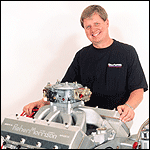By David Reher, Reher-Morrison Racing Engines
“As a professional engine builder, I’m not concerned about the brand on a block.”
Growing up among gearheads, we all knew guys who swore lifetime allegiance to a brand. It was a snap to identify the Chevy guys, the Ford guys, and the Chrysler guys.
They wore their loyalty as a badge of honor on T-shirts, belt buckles, and the occasional tattoo. I suppose that today there are Honda guys and Toyota guys, too, but I don’t travel in those circles.
As a professional engine builder, I’m not concerned about the brand on a block. When I evaluate an engine’s potential, I look at its parameters: What is the bore spacing, how much valve area can it accommodate, what is the airflow potential of the ports, how much do the rotating and reciprocating parts weigh? The answers determine whether an engine is a potential race winner.
When I got serious about racing in the ’70s, the small-block Chevy V8 dominated Modified eliminator. Now 40 years later, the buzz is still about small-blocks – but today it’s GM’s LS engine family. Judging by the volume of magazine articles, online forums, and events devoted specifically to the LS series, it’s the next big thing.
I certainly respect the performance of the LS engine series. Yet as I noted earlier, an engine is an assembly of components that represents the best compromise between cost, complexity, performance, economy, reliability, and serviceability. Like any engine, the LS small-block has strong and weak points. So here is my personal perspective on the LS engine family.
The LS series brought competition cylinder head technology to the street. The valve angle, valve bowls, and runner shapes have their roots in racing. It’s not coincidental that the LS cylinder heads bear a strong resemblance to the Stage II Buick V8 heads that were successful in Comp eliminator in the early ’90s. The Buick V8 heads were based on the high-port V6 cylinder developed for Buick’s Indy car program. In fact, I met my partner and friend Bruce Allen when he was doing dyno development on turbocharged Buick V6 Indy car engines at McLaren.
Buick had hoped to use the Stage II heads in NASCAR Winston Cup, where the division had a successful racing program with drivers like Bobby Allison and Darrell Waltrip. The Buick V8 heads (which were designed to fit the small-block Chevy V8) were not approved by NASCAR, but they found a home in drag racing. Manufactured by Richard Maskin’s Dart Machinery, they had a GM part number (25500141), and consequently were legal in classes that required factory-produced heads.
The Dart/Buick hybrid heads differed from conventional small-block heads in significant ways. First, they had equally spaced intake and exhaust ports; unlike small-block heads, the runners weren’t siamesed. The valve angle was 10 degrees, much shallower than the small-block’s 23-degree valve angle. The LS1’s replicated ports and 15-degree valve angle are testaments to the fact that key GM engineers were well aware of the hybrid Buick V8’s performance.
I don’t recommend the original LS1 cylinder heads with tall, narrow “cathedral” intake ports. The LS engine really came of age with the introduction of the LS3 version with rectangular ports, 2.160-inch diameter intake valves, and offset intake rocker arms.
Unfortunately, the rocker box on all LS heads is really too small to accommodate a racing valvetrain, so fabricated valve covers are almost a necessity. The stock rocker arm trunions are another weak point; aftermarket replacements are highly recommended.
Ten head bolts are not enough to seal a high-output LS engine reliably. Fortunately, heavy-duty factory and aftermarket blocks are available with 18 head bolts that clamp the head gasket more securely than the production bolt pattern.
I’m not a fan of the production LS engine’s oiling system, which uses one of the lifter oil galleries to supply the main bearings. Spit out a lifter for any reason and oil flow to the crankshaft stops. I strongly prefer the aftermarket blocks with true priority main oiling systems.
The LS engine’s gerotor oil pump on the nose of the crankshaft is a good thing, since it eliminates problems with the distributor-driven oil pump gears that plagued Gen I small-blocks since the early days.
The LS engine’s 55mm diameter camshaft is also a step forward. This large-diameter cam has increased torsional stiffness and facilitates high-lift profiles.
The production LS aluminum block’s performance potential exceeds the strength of the casting. In other words, it’s easy to make more horsepower than a stock block can withstand. The 318 aluminum alloy is all right for a mild street engine, but even the factory recognizes its shortcomings and specifies 356 aluminum for supercharged versions. For my money, the 357 alloy that’s used in some aftermarket blocks is definitely the way to go for a serious LS engine.
The LS engine’s block has skirts that extend below the crankshaft centerline. This Y-block design reduces noise and vibration in a street car, but it’s not what you want in a racing engine. An oil pan with a kick-out and scraper minimizes windage losses, and that requires a block that doesn’t extend below the crank centerline.
The LS engine has the same 4.40-inch cylinder bore spacing as the Gen I small-block, but its crankshaft is one inch shorter. Shortening the overall length made it possible to install LS engines transversely in front-wheel drive models, but for racing applications, the crankshaft’s small counterweights make it difficult to balance. There is really no easy solution except to install heavy metal in the counterweights.
The shift to LS engines is reflected in inquiries from our customers and our engine and parts sales. There is still plenty of life left in the Gen I small-block, but the LS series is coming on strong.

